
Pitch Notes: Title Update #5
Pitch Notes

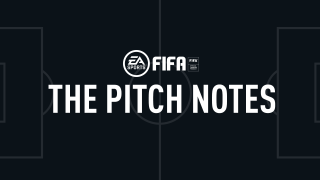
Hi FIFA fans,
Title Update #5 (TU#5) is now available for PlayStation 4, Xbox One, and PC.
In this Pitch Notes article, we will be taking a more detailed look at some of the gameplay changes contained in this TU.
For the full list of changes and updates in TU#5, be sure to head over to our forums.
Drop Back Defensive Tactic
We’ve been hearing the feedback from our community regarding the Drop Back Defensive Tactic, so in TU#5, we’ve made the following change:
- When losing possession and transitioning into the Drop Back Defensive Tactic, the defensive team will no longer apply any pressure to the attacking team.
- This change is intended to bring the tactic closer in-line with how it is portrayed on the real life pitch.
- As a result of this change, the offensive player can have more space to use in order to build an attack after winning the ball back.
To provide more context, prior to this change, every Defensive Tactic in FIFA 20 resulted in defending teams applying various levels of pressure to the attacking team. This pressure would occur once a team loses possession of the ball and transitions into defending, and it’s designed to prevent the potential of constant counter attacks.
After identifying how Drop Back was being used in-game, we have decided to remove the aforementioned pressure, for this tactic only, in order to bring more alignment between the tactic and its real-world counterpart.
With this change, an attacking team who have just taken the ball away from a team that has Drop Back set as their Defensive Tactic can end up in situations with more open space when building up their attack, specifically in the moments following the transition to attack, as they will not be pressured by the defensive team.
Note that when you’re in possession of the ball, none of FIFA 20’s Defensive Tactics impact your team’s attacking behavior, that’s when the Offensive Tactics come into effect.
We will continue to monitor both community feedback and our internal data regarding the Drop Back Tactic going forward.
Tackling
We’ve been investigating the community’s feedback around successful tackles resulting in the ball being kept by the attacking player too often. In TU#5 we have made the following changes in order to reduce the instances of this happening:
- Increased likelihood of ball carrier stumbling after being successfully tackled when the defensive player performs the Standing Tackle action.
- The direction of the stumble is more influenced by the direction the defender tackles from.
- During the stumble, the tackled player is no longer able to take control of the ball.
With this change, when a player is successfully tackled they are more likely to stumble as a result of that tackle. The stumbling player will no longer be able to take control of the ball while they are in the midst of that stumble, whereas previously, before TU#5, it was possible for them to gain control of the ball in this state.
It’s important to note that this will only apply when the defending player actually uses the Tackle button, not when attempting to tackle using only positioning or when performing a Sliding Tackle.
We will continue to monitor this behavior going forward.
Finishing And Long Shot Attributes
We’ve made some adjustments to how Finishing and Long Shot Attributes are used in FIFA 20, across all types of shots:
- Made the following changes to the Long Shot and Finishing Attributes:
- The Long Shot Attribute had been updated to now impact the results of a shot taken from 65 feet, or further away from the target.
- The target is the exact location of where the ball is expected to go, determined through a mixture of directional input, and the Shooting Assistance setting.
- The Finishing Attribute impacts shot results from 55 feet, or closer, to the target.
- Shots between 55 and 65 feet from the target will now use a weighted average of the Long Shot and Finishing Attributes when impacting shot results.
- The Long Shot Attribute had been updated to now impact the results of a shot taken from 65 feet, or further away from the target.
Our design intent with this change is to enable players with a high Long Shot Attribute to take better long distance shots. Similarly, this change is intended to lower the quality of long shots coming from players with high Finishing but low Long Shot Attributes. It’s not intended to reduce the general effectiveness of shooting, but rather to better reflect which players should be having more success taking these types of shots.
In the notes above, we use the term “target.” In this instance, we are referring to the exact location the ball is expected to go to. The final placement of the ball will not always be at the target due to the player’s attributes and error. The target is determined through a mixture of directional input and the Shooting Assistance setting.
The situations where only Finishing or only Long Shots are used should be fairly clear, but the last change, which uses a combination of the two Attributes is a little more complicated, so let’s dig in. Shots taken between 55 feet/16.7 meters/18.3 yards and 65 feet/19.8 meters/21.6 yards are impacted by a weighted average of the Finishing and Long Shot Attributes. The balance between the weight percentages shifts towards the Long Shot Attribute as the distance from the target increases and shifts towards the Finishing Attribute as the distance from the target decreases.
This change does not impact other factors that could play into a shooting situation, such as but not limited to: shot power, composure, pressure from the defender, angle of the shot, quality of contact with the ball, etc.
So to recap this change clearly, here is how these two Attributes come into play with TU#5 active:
- Shot taken from 55 feet or less:
- Finishing Attribute has an impact on the result.
- Long Shots Attribute has no impact on the result.
- Shot taken from between 55 feet and 65 feet:
- Finishing Attribute and Long Shots Attribute both have an impact on the result through a weighted average.
- The weight in the average for each attribute is determined by how close to the 55 or 65 foot boundary the shot is being taken from.
- Closer to 55 Feet, the weighted average is shifted more to Finishing.
- Closer to 65 Feet, the weighted average is shifted more to Long Shots.
- Shot taken from 65 feet or further:
- Long Shots Attribute has an impact on the result.
- Finishing Attribute has no impact on the result.
To reiterate, this change impacts all types of shots, including Finesse Shots, Chip Shots, and Low Driven Shots.
Let’s take a look at some visuals to demonstrate our intention with this change. In the next 2 images, a player with 55 Finishing and 95 Long Shots will be taking a shot from 68 feet/20.7 meters/22.6 yards.
55 Finishing and 95 Long Shot Before TU#5
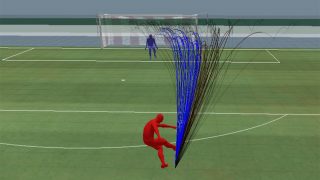
Note how this player’s shot has significant error in this situation because of their low Finishing Attribute.
55 Finishing and 95 Long Shot Attributes After TU#5
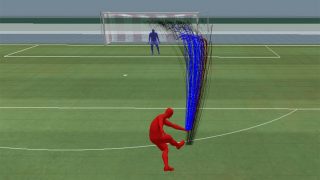
With the change in TU#5, the player’s shots have much less error in this scenario, with a much tighter spread of shots. This is because of their high Long Shot Attribute. Remember, this player has 55 Finishing and 95 Long Shots.
To be clear, this change does not mean all long shots from all players will be more likely to go on target or score. Let’s take a look at a player with 95 Finishing but 55 Long Shots, also being taken from 68 feet/20.7 meters/22.6 yards.
95 Finishing and 55 Long Shot Attributes Before TU#5
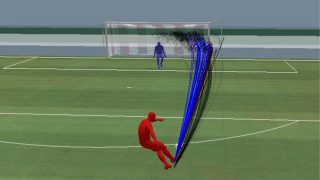
Despite a low Long Shot Attribute, this player is still able to get many shots on target in this scenario due to their high Finishing Attribute. Now let’s take a look at the change in TU#5.
95 Finishing and 55 Long Shot Attributes After TU#5
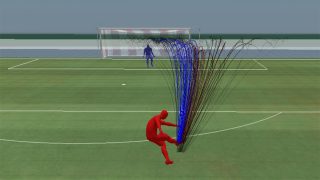
Note how the same shot from the same player now has much more error. This is because of their 55 Long Shot Attribute.
Off-Target Shots
In TU #5 we made a change to shots taken from certain distances in order to complement the Attribute impact changes listed above.
- Increased the likelihood of shots going off-target when taken from 45 feet, or further, from the target.
- The impact of this change scales upwards between 45 and 55 feet, with the maximum impact capping at 55.
- This means that any shot from 55 feet away, or greater, from the target will be more likely to go off target.
Since this TU makes Player Items with a high Long Shot Attribute able to perform better long distance shots, we slightly tweaked the amount of error in order to prevent these shots from becoming very unrealistic.
At 45 feet/15 yards/13.7 meters, this change has no impact on shots. At this distance, the change begins to scale upwards.
At 55 feet/18.3 yards/16.7 meters, this change has a very low impact on shots.
Here’s how a 55 foot shot could have looked before TU #5:
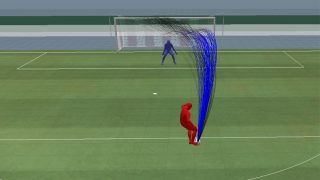
Now let’s take a look at how a 55 foot shot behaves after TU #5:
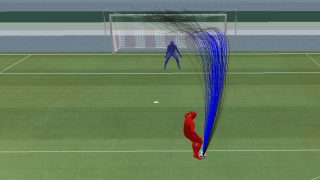
As you can see, the change at this distance is minor. In these screenshots, we used Eden Hazard, who has 84 Finishing. As a player, you might notice more of an impact when performing difficult shots at much longer distances, like in the screenshots posted earlier in this Pitch Notes.
First-Time Shots And Volleys From The Edge Of The Box (And Beyond)
In TU#5, we’ve made the following adjustment to first-time shots and volleys, when they are being taken from near the edge of the 18 yard box and beyond.
- Reduced effectiveness of first-time shots and volleys from the edge of the box and beyond.
- Increased error for difficult first time shots and all volleys resulting in potentially less accuracy, speed, and spin.
- Increased incoming ball velocity impact on first time shot error calculation.
- Increased impact of vertical ball velocity on volley error calculation.
- Increased error for difficult first time shots and all volleys resulting in potentially less accuracy, speed, and spin.
To break this down further, let’s start with the first time shot aspect of this change. Any time you take a first time shot from outside the box the shot will now have increased error. This will potentially result in less accuracy, spin, and speed.
To help visualize the impact of this change, here is a before and after spray chart of Eden Hazard taking a first-timed shot from outside of the box.
First-Time Shot Before TU#5
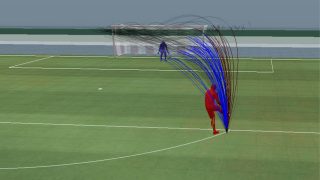
First-Time Shot After TU#5
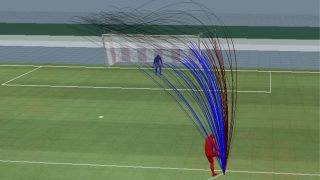
Note that with TU#5, Hazard’s first-time shot has more error, and that there’s a wider spread of potential shot results. The intention of this change is to reduce the effectiveness of these types of shots, and to bring the success rate of them more in-line with what would happen on the real world pitch.
Now, looking at volleys, similar to the previous change, we’ve increased the impact of ball velocity on a volley, but in this case the velocity we are focused on is vertical ball velocity, which refers to the falling speed of the ball when it reaches the player who’s planning to perform a volley. Higher vertical velocity should result in a more error-prone shot, and we’ve increased the impact of that velocity in TU#5.
Since volleys can be impacted by both the incoming ball velocity and vertical ball velocity changes in some situations, the combination of the two changes will result in these shots bring impacted by more error than prior to TU#5.
Ground & Driven Ground Passes
In an effort to reduce the effectiveness of long range passes being taken from difficult angles, TU#5 contains the following changes to passing:
- Ground Passes and Driven Ground Passes taken from difficult angles will now result in the ball traveling with less velocity.
- This change only affects passes of a certain distance, starting at 40 feet, and scaling upward, with the maximum impact being at 60 feet, which will impact passes at 60 feet and beyond.
- This change affects all ground passes that are performed between 100 to 180 degrees and 260 to 180 degrees, where 0 degrees is the direction the player is facing.
- The impact of this change scales upwards from 100 to 180 and 260 to 180, with the greatest impact at 140 to 180 degrees and 220 to 180 degrees.
- This change only impacts scenarios where both of the above situations are true.
This change is impacted by two different factors, the distance of the pass being attempted, and the angle that the player is aiming the pass at compared to where the player is facing at the time the pass is requested.
Both of these factors must be in play for the change to have an impact on the pass, though the impact will scale depending on how much each of these factors comes into play.
First, let’s talk about distance. This change will only affect passes of a certain distance, starting at 40 feet/12.1 meters/13.3 yards, and scaling upward, with the maximum impact being at 60 feet/18.3 meters/20 yards, which will then impact passes at 60 feet and beyond. This means that the maximum effect of the distance portion of this change applies to a pass from 60 feet or beyond.
Next, let’s focus on angles. This change affects all ground passes that are performed between 100 to 180 degrees and 260 to 180 degrees. For reference, 0 degrees is the direction the player is facing. The impact of this change scales upwards from 100 to 180 and 260 to 180, with the greatest impact at 140 to 180 degrees and 220 to 180 degrees.
Here is a diagram visualizing the angles explanation above.

The 0 degrees, at the top of the circle, represents where the player is facing at the time that the request for a pass is made. If the target for the pass is somewhere between 100 to 260 degrees, this change would have some level of impact, as those angles are out of the player’s line of sight. resulting in more difficult passes.
Again, this change only comes into play when the pass would trigger both of the conditions above. Just being a long distance pass, or just being a pass being taken at a difficult angle will not trigger the effects of this change. For example, this change would not impact a 60 foot/18.3 meter/20 yard pass from 90 degrees.
Ultimately the goal of this change is to introduce more risk around long range passes where the passing player is not actively looking in the direction of the pass when it is being requested. For example, trying to counter attack from a Drop Back defensive situation by using blind, long range passes can be riskier due to the nature of this passing change.
__
Thanks everyone for checking out the latest Pitch Notes. I hope this article has given you more insight into the changes we’ve made to FIFA 20 in TU#5. As always, you can head over to the FIFA Forums to discuss this article. Cheers!
Goran Popovic, Joel Doonan, Tom Caleffi, and the FIFA Team
--
For more deep dives on FIFA from members of the game team, check out the Pitch Notes Page.
Please Note: This article is describing in general terms what updates are implemented in Title Update #5 in FIFA 20 on PlayStation 4, Xbox One and PC, and how we are seeing them work in our development/test environments. Please remember performance may differ in a live environment and that we are constantly looking to improve the gameplay experience for everyone and this article may become outdated as we make adjustments to keep our game fun for everyone.
FIFA 20 is available now for PlayStation 4, Xbox One, and PC.
Stay in the conversation on all things FIFA by liking us on Facebook , following us on Twitter and Instagram , and participating in the official FIFA Forums . Sign-up to receive emails about EA SPORTS FIFA and EA products, news, events, and promotions.

